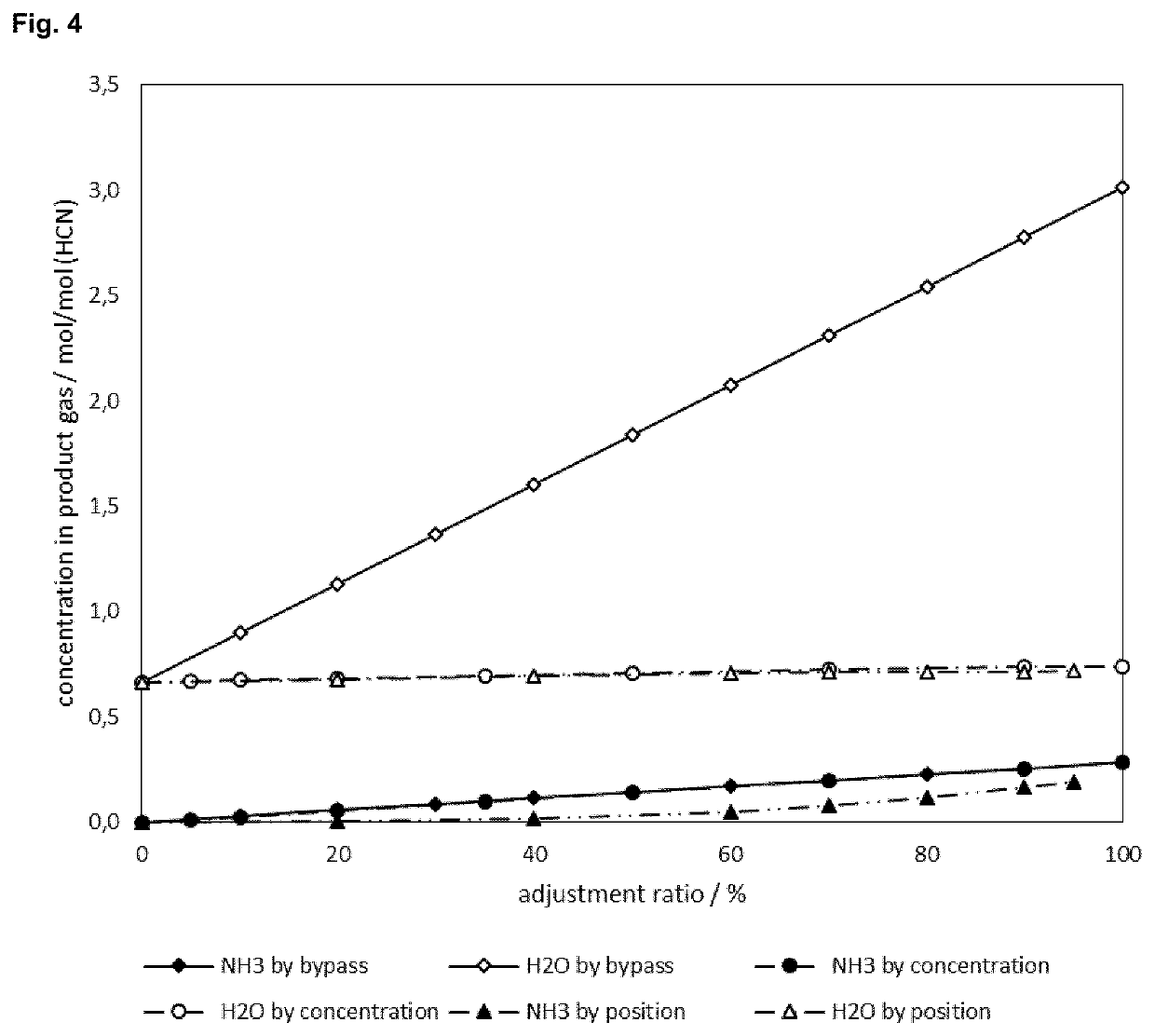Method for producing methionine
a methionine and sulfide technology, applied in the field of methionine production, can solve the problems of high production cost, loss of raw materials, and inability to simply be removed and discarded, and achieve the effect of high effort in biological waste water treatmen
- Summary
- Abstract
- Description
- Claims
- Application Information
AI Technical Summary
Benefits of technology
Problems solved by technology
Method used
Image
Examples
example 1
[0106]Production of MMP-Cyanohydrin from Ammonia Containing Hydrocyanic Acid without Ammonia Adjustment Unit
[0107]188 g of 3-methylthiopropionaldehyde (methylmercaptopropionaldehyde, MMP) (94.0 wt %, 1.00 equiv.) from industrial production were metered in at a rate of 6 g / min at the top of a bubble-tray column temperature-controlled at 55° C. (5 trays, double jacketed) equipped with a reflux condenser. At the bottom of the column an Andrussow gas mixture containing hydrocyanic acid (47.0 g, 1.02 equiv. based on MMP, 90 g / h), ammonia (7.99 g, 0.28 equiv. based on MMP, 15.3 g / h), steam (80 g, 156 g / h) and nitrogen (230 NL, 450 NL / h) (NH3:HCN=0.27 mol / mol) was added by countercurrent principle. The product was collected in a flask fixed to the bottom of the column and analyzed after completion of the MMP addition (ca. 30 min). A clear, colourless biphasic product was obtained: one part aqueous layer at the top and five parts organic layer at the bottom. HPLC analysis revealed a total c...
example 2
[0108]Miscibility of Ammonia Containing MMP-Cyanohydrin Equivalents with Water
[0109]An ammonia adjustment unit will alter both the ammonia and water content in the HCN gas. In order to determine the limit of water allowed to receive the resultant ammonia-containing MMP-CN equivalents as a single phase, miscibility experiments of water and MMP-CN with varying ammonia content were conducted.
[0110]In a three-necked flask cooled in an ice bath, equipped with jacketed coil condenser and thermometer, gaseous ammonia was slowly passed through a mechanically stirred sample of 93 g of MMP-cyanohydrin (96% by weight, 1.0 equiv.) until differential weighing confirmed addition of 1.16 g (0.1 equiv.) of ammonia (NH3:HCN=0.10 mol / mol). The resultant solution was allowed to warm to room temperature and stirred for three days. HPLC analysis confirmed complete conversion of the ammonia to iminodinitrile; MMP-AN was not present. 10 g of the mixture were cooled to 10° C. in a double-jacketed flask and...
example 3
Adjustment of the NH3 to HCN Ratio and the Water Content for the Andrussow Process to Avoid the Separation of Two Liquid Phases
[0112]A standard crude hydrogen cyanide reaction gas stream (3) produced by an Andrussow reaction step comprising 6.5 mol % hydrogen cyanide, 1.8 mol % ammonia and 19.6 mol % water is fed to the ammonia adjustment unit (IHS Chemical PEP Review 2015-07 “Hydrogen Cyanide by the Andrussow and BMA Process”). The ammonia and water contents after the adjustment step by bypassing (4) the sulfuric acid washer (B) are calculated for bypass ratios from 0 to 100%. The adjusted hydrogen cyanide stream (9) used in an MMP-cyanohydrin reaction step (D) with pure MMP (10) as reacting agent leads to a corresponding water content in the MMP-cyanohydrin equivalents solution (12) as shown in FIG. 3 (indicated as “Bypass”). The data labels inside the diagram represent the bypass ratio (percentage of reaction gas stream that is led via the bypass) or the ammonia breakthrough rati...
PUM
| Property | Measurement | Unit |
|---|---|---|
| Fraction | aaaaa | aaaaa |
| Fraction | aaaaa | aaaaa |
| Fraction | aaaaa | aaaaa |
Abstract
Description
Claims
Application Information
 Login to View More
Login to View More - R&D
- Intellectual Property
- Life Sciences
- Materials
- Tech Scout
- Unparalleled Data Quality
- Higher Quality Content
- 60% Fewer Hallucinations
Browse by: Latest US Patents, China's latest patents, Technical Efficacy Thesaurus, Application Domain, Technology Topic, Popular Technical Reports.
© 2025 PatSnap. All rights reserved.Legal|Privacy policy|Modern Slavery Act Transparency Statement|Sitemap|About US| Contact US: help@patsnap.com



